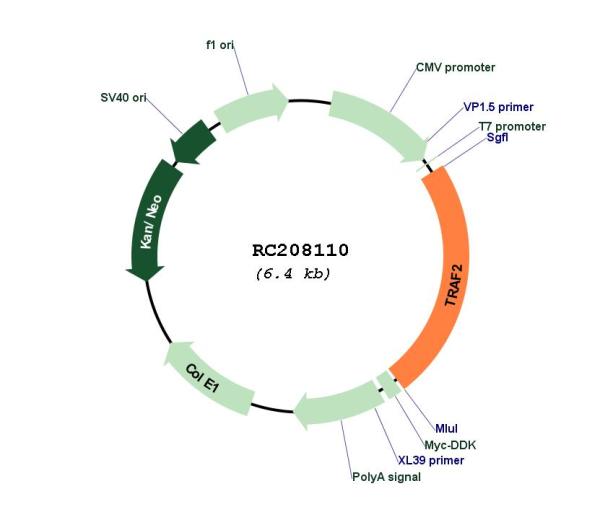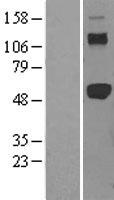TRAF2 (NM_021138) Human Tagged ORF Clone
CAT#: RC208110
TRAF2 (Myc-DDK-tagged)-Human TNF receptor-associated factor 2 (TRAF2)
ORF Plasmid: tGFP
"NM_021138" in other vectors (6)
Need custom modification / cloning service?
Get a free quote
CNY 3,728.00
CNY 3,990.00
| Cited in 4 publications. |
CNY 300.00
Specifications
| Product Data | |
| Type | Human Tagged ORF Clone |
| Tag | Myc-DDK |
| Synonyms | MGC:45012; RNF117; TRAP; TRAP3 |
| Vector | pCMV6-Entry |
| E. coli Selection | Kanamycin (25 ug/mL) |
| Mammalian Cell Selection | Neomycin |
| Sequence Data |
>RC208110 ORF sequence
Red=Cloning site Blue=ORF Green=Tags(s) TTTTGTAATACGACTCACTATAGGGCGGCCGGGAATTCGTCGACTGGATCCGGTACCGAGGAGATCTGCC GCCGCGATCGCC ATGGCTGCAGCTAGCGTGACCCCCCCTGGCTCCCTGGAGTTGCTACAGCCCGGCTTCTCCAAGACCCTCC TGGGGACCAAGCTGGAAGCCAAGTACCTGTGCTCCGCCTGCAGAAACGTCCTCCGCAGGCCCTTCCAGGC GCAGTGTGGCCACCGGTACTGCTCCTTCTGCCTGGCCAGCATCCTCAGCTCTGGGCCTCAGAACTGTGCT GCCTGTGTTCACGAGGGCATATATGAAGAAGGCATTTCTATTTTAGAAAGCAGTTCGGCCTTCCCAGATA ATGCTGCCCGCAGGGAGGTGGAGAGCCTGCCGGCCGTCTGTCCCAGTGATGGATGCACCTGGAAGGGGAC CCTGAAAGAATACGAGAGCTGCCACGAAGGCCGCTGCCCGCTCATGCTGACCGAATGTCCCGCGTGCAAA GGCCTGGTCCGCCTTGGTGAAAAGGAGCGCCACCTGGAGCACGAGTGCCCGGAGAGAAGCCTGAGCTGCC GGCATTGCCGGGCACCCTGCTGCGGAGCAGACGTGAAGGCGCACCACGAGGTCTGCCCCAAGTTCCCCTT AACTTGTGACGGCTGCGGCAAGAAGAAGATCCCCCGGGAGAAGTTTCAGGACCACGTCAAGACTTGTGGC AAGTGTCGAGTCCCTTGCAGATTCCACGCCATCGGCTGCCTCGAGACGGTAGAGGGTGAGAAACAGCAGG AGCACGAGGTGCAGTGGCTGCGGGAGCACCTGGCCATGCTACTGAGCTCGGTGCTGGAGGCAAAGCCCCT CTTGGGAGACCAGAGCCACGCGGGGTCAGAGCTCCTGCAGAGGTGCGAGAGCCTGGAGAAGAAGACGGCC ACTTTTGAGAACATTGTCTGCGTCCTGAACCGGGAGGTGGAGAGGGTGGCCATGACTGCCGAGGCCTGCA GCCGGCAGCACCGGCTGGACCAAGACAAGATTGAAGCCCTGAGTAGCAAGGTGCAGCAGCTGGAGAGGAG CATTGGCCTCAAGGACCTGGCGATGGCTGACTTGGAGCAGAAGGTCTTGGAGATGGAGGCATCCACCTAC GATGGGGTCTTCATCTGGAAGATCTCAGACTTCGCCAGGAAGCGCCAGGAAGCTGTGGCTGGCCGCATAC CCGCCATCTTCTCCCCAGCCTTCTACACCAGCAGGTACGGCTACAAGATGTGTCTGCGTATCTACCTGAA CGGCGACGGCACCGGGCGAGGAACACACCTGTCCCTCTTCTTTGTGGTGATGAAGGGCCCGAATGACGCC CTGCTGCGGTGGCCCTTCAACCAGAAGGTGACCTTAATGCTGCTCGACCAGAATAACCGGGAGCACGTGA TTGACGCCTTCAGGCCCGACGTGACTTCATCCTCTTTTCAGAGGCCAGTCAACGACATGAACATCGCAAG CGGCTGCCCCCTCTTCTGCCCCGTCTCCAAGATGGAGGCAAAGAATTCCTACGTGCGGGACGATGCCATC TTCATCAAGGCCATTGTGGACCTGACAGGGCTC ACGCGTACGCGGCCGCTCGAGCAGAAACTCATCTCAGAAGAGGATCTGGCAGCAAATGATATCCTGGATT ACAAGGATGACGACGATAAGGTTTAA >RC208110 protein sequence
Red=Cloning site Green=Tags(s) MAAASVTPPGSLELLQPGFSKTLLGTKLEAKYLCSACRNVLRRPFQAQCGHRYCSFCLASILSSGPQNCA ACVHEGIYEEGISILESSSAFPDNAARREVESLPAVCPSDGCTWKGTLKEYESCHEGRCPLMLTECPACK GLVRLGEKERHLEHECPERSLSCRHCRAPCCGADVKAHHEVCPKFPLTCDGCGKKKIPREKFQDHVKTCG KCRVPCRFHAIGCLETVEGEKQQEHEVQWLREHLAMLLSSVLEAKPLLGDQSHAGSELLQRCESLEKKTA TFENIVCVLNREVERVAMTAEACSRQHRLDQDKIEALSSKVQQLERSIGLKDLAMADLEQKVLEMEASTY DGVFIWKISDFARKRQEAVAGRIPAIFSPAFYTSRYGYKMCLRIYLNGDGTGRGTHLSLFFVVMKGPNDA LLRWPFNQKVTLMLLDQNNREHVIDAFRPDVTSSSFQRPVNDMNIASGCPLFCPVSKMEAKNSYVRDDAI FIKAIVDLTGL TRTRPLEQKLISEEDLAANDILDYKDDDDKV |
| Chromatograms |
CHROMATOGRAMS
 Sequencher program is needed, download here. |
| Restriction Sites |
SgfI-MluI
Cloning Scheme for this gene
Plasmid Map

|
| ACCN | NM_021138 |
| ORF Size | 1503 bp |
| OTI Disclaimer | The molecular sequence of this clone aligns with the gene accession number as a point of reference only. However, individual transcript sequences of the same gene can differ through naturally occurring variations (e.g. polymorphisms), each with its own valid existence. This clone is substantially in agreement with the reference, but a complete review of all prevailing variants is recommended prior to use. More info |
| OTI Annotation | This clone was engineered to express the complete ORF with an expression tag. Expression varies depending on the nature of the gene. |
| Product Components | The ORF clone is ion-exchange column purified and shipped in a 2D barcoded Matrix tube containing 10ug of transfection-ready, dried plasmid DNA (reconstitute with 100 ul of water). |
| Reconstitution | 1. Centrifuge at 5,000xg for 5min. 2. Carefully open the tube and add 100ul of sterile water to dissolve the DNA. 3. Close the tube and incubate for 10 minutes at room temperature. 4. Briefly vortex the tube and then do a quick spin (less than 5000xg) to concentrate the liquid at the bottom. 5. Store the suspended plasmid at -20°C. The DNA is stable for at least one year from date of shipping when stored at -20°C. |
| Note | Plasmids are not sterile. For experiments where strict sterility is required, filtration with 0.22um filter is required. |
| Reference Data | |
| RefSeq | NM_021138.4 |
| RefSeq Size | 2298 bp |
| RefSeq ORF | 1506 bp |
| Locus ID | 7186 |
| UniProt ID | Q12933 |
| Domains | zf-TRAF, RING, MATH |
| Protein Families | Druggable Genome |
| Protein Pathways | Adipocytokine signaling pathway, Apoptosis, MAPK signaling pathway, Pathways in cancer, RIG-I-like receptor signaling pathway, Small cell lung cancer |
| MW | 55.9 kDa |
| Gene Summary | The protein encoded by this gene is a member of the TNF receptor associated factor (TRAF) protein family. TRAF proteins associate with, and mediate the signal transduction from members of the TNF receptor superfamily. This protein directly interacts with TNF receptors, and forms a heterodimeric complex with TRAF1. This protein is required for TNF-alpha-mediated activation of MAPK8/JNK and NF-kappaB. The protein complex formed by this protein and TRAF1 interacts with the inhibitor-of-apoptosis proteins (IAPs), and functions as a mediator of the anti-apoptotic signals from TNF receptors. The interaction of this protein with TRADD, a TNF receptor associated apoptotic signal transducer, ensures the recruitment of IAPs for the direct inhibition of caspase activation. BIRC2/c-IAP1, an apoptosis inhibitor possessing ubiquitin ligase activity, can unbiquitinate and induce the degradation of this protein, and thus potentiate TNF-induced apoptosis. Multiple alternatively spliced transcript variants have been found for this gene, but the biological validity of only one transcript has been determined. [provided by RefSeq, Jul 2008] |
Citations (4)
| The use of this cDNA Clones has been cited in the following citations: |
|---|
|
Parkin facilitates proteasome inhibitor-induced apoptosis via suppression of NF-κB activity in hepatocellular carcinoma
,Zhang, X;Lin, C;Song, J;Chen, H;Chen, X;Ren, L;Zhou, Z;Pan, J;Yang, Z;Bao, W;Ke, X;Yang, J;Liang, Y;Huang, H;Tang, D;Jiang, L;Liu, J;,
Cell Death Dis
,PubMed ID 31558697
[TRAF2]
|
|
A parapoxviral virion protein targets the retinoblastoma protein to inhibit NF-κB signaling
,Nagendraprabhu, P;Khatiwada, S;Chaulagain, S;Delhon, G;Rock, DL;,
PLoS Pathog.
,PubMed ID 29244863
[TRAF2]
|
|
Caspase-10: a molecular switch from cell-autonomous apoptosis to communal cell death in response to chemotherapeutic drug treatment
,Mohr, A;Deedigan, L;Jencz, S;Mehrabadi, Y;Houlden, L;Albarenque, SM;Zwacka, RM;,
Cell Death Differ.2017
,PubMed ID 29099485
[TRAF2]
|
|
Cleavage of Interferon Regulatory Factor 7 by Enterovirus 71 3C Suppresses Cellular Responses
,Xiaobo Lei, Xia Xiao, Qinghua Xue, Qi Jin, Bin He, and Jianwei Wang,
J. Virol., Feb 2013; 87: 1690 - 1698.
[TRAF2]
|
Documents
| Product Manuals |
| FAQs |
| SDS |
Resources
Other Versions
| SKU | Description | Size | Price |
|---|---|---|---|
| RC208110L1 | Lenti ORF clone of Human TNF receptor-associated factor 2 (TRAF2), Myc-DDK-tagged |
CNY 6,128.00 |
|
| RC208110L2 | Lenti ORF clone of Human TNF receptor-associated factor 2 (TRAF2), mGFP tagged |
CNY 5,890.00 |
|
| RC208110L3 | Lenti ORF clone of Human TNF receptor-associated factor 2 (TRAF2), Myc-DDK-tagged |
CNY 5,890.00 |
|
| RC208110L4 | Lenti ORF clone of Human TNF receptor-associated factor 2 (TRAF2), mGFP tagged |
CNY 6,128.00 |
|
| RG208110 | TRAF2 (tGFP-tagged) - Human TNF receptor-associated factor 2 (TRAF2) |
CNY 5,320.00 |
|
| SC111044 | TRAF2 (untagged)-Human TNF receptor-associated factor 2 (TRAF2) |
CNY 3,736.00 |


 United States
United States
 Germany
Germany
 Japan
Japan
 United Kingdom
United Kingdom
 China
China




